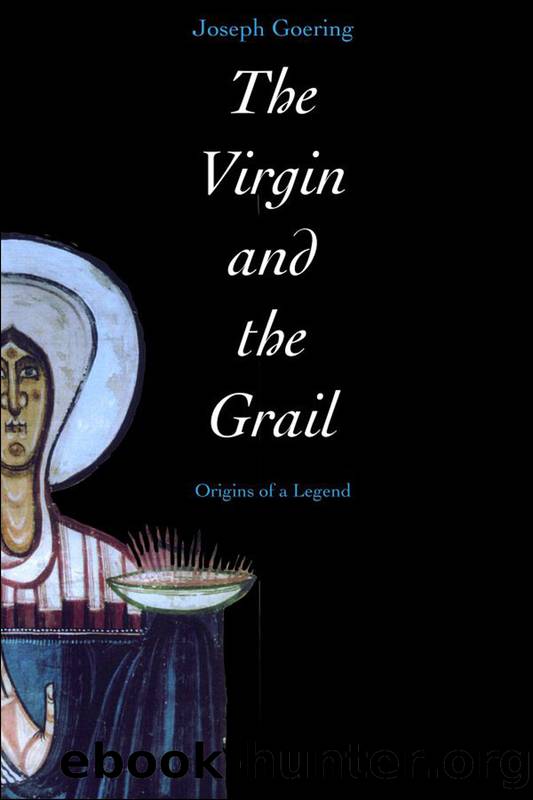The Virgin and the Grail by Goering Joseph Ward

Author:Goering, Joseph Ward [Goering, Joseph Ward]
Language: eng
Format: epub
ISBN: 9780300138207
Publisher: YaleUP
Published: 2005-09-15T05:00:00+00:00
Fig. 4 Three magi and their grails. Detail from the west wall of Santa Maria of Taüll. Fresco. Circa 1123. Museu Nacional dâArt de Catalunya (Barcelona).
Fig. 5 Last Supper (detail). From the church of St. Baudel near Berlanga. Fresco. Circa 1120â1140. Maria Antoinette Evans Fund. Museum of Fine Arts, Boston.
That the grail held by the Virgin of Taüll is a holy vessel, or at least contains something holy, is demonstrated by the way she holds it in her covered handâa traditional gesture signifying the sacredness of the thing she is bearingâand by the reddish-orange rays emanating from the bowl. It would be accurate, then, to describe this painting in the church of St. Clement of Taüll as an image of the Virgin Mary with a holy grail. What might have moved the artist to introduce a piece of common tableware into his painting, and to treat it as something holy, is hard to discern. Perhaps there was a local tradition in the Pyrenees that told a story of the Virgin appearing with a fiery dish or bowl; if so, no trace of such has yet been found.15 But whatever the cause, it is fitting that we give tentative credit to the Master of St. Clement, that âmost astonishing inventors of forms of the entire Romanesque period,â for inventing this image, or at the very least for presenting it in a wonderfully striking and beautiful way.
Should we also associate this image with the famous Grail of the Arthurian romances, composed more than fifty years later by Chrétien de Troyes, Wolfram von Eschenbach, and Robert de Boron? Modern scholars have not been slow to make this association. Chandler Rathfon Post, whose History of Spanish Painting (1930) remains authoritative, and who was steeped in the scholarship on these Romanesque murals from the time of their discovery, describes the image in St. Clement thus: âAmidst the Apostles ⦠appears the Virgin holding a cup which has been tentatively explained as the Holy Grail because Montserrat in Catalonia is connected with this legend and because the vessel seems to be filled with the Sacred Blood emitting miraculous rays.â16 Otto Demus, in his magisterial survey of Romanesque Mural Painting, is unequivocal. He writes of this image: âThe Virgin ⦠holds up a dish filled with the glowing blood of Christ, a reminder that Catalonia was one of the centres of the cult of the Grail.â Demus adds: âThe pictorial representation of the Grail ⦠evidently precedes by a number of decades the earliest known treatments of the legend in poetry.â17 In his Pictorial Arts of the West, 800â1200, C. R. Dodwell echoes these views, and discusses this image as one of âthe earliest allusion[s] to the Grail in art or literature.â18
Caution is called for. These interpretations presume that already in 1123 there existed a popular story of the Grail to which the Master of St. Clement could âalludeâ in his painting. They assume, further, that the story to which the painter makes allusion is one that associates the Grail with a eucharistic chalice and with the blood of Christ.
Download
This site does not store any files on its server. We only index and link to content provided by other sites. Please contact the content providers to delete copyright contents if any and email us, we'll remove relevant links or contents immediately.
The Power of Myth by Joseph Campbell & Bill Moyers(1036)
Half Moon Bay by Jonathan Kellerman & Jesse Kellerman(965)
A Social History of the Media by Peter Burke & Peter Burke(961)
Inseparable by Emma Donoghue(954)
The Nets of Modernism: Henry James, Virginia Woolf, James Joyce, and Sigmund Freud by Maud Ellmann(867)
The Spike by Mark Humphries;(783)
The Complete Correspondence 1928-1940 by Theodor W. Adorno & Walter Benjamin(765)
A Theory of Narrative Drawing by Simon Grennan(757)
Culture by Terry Eagleton(756)
Ideology by Eagleton Terry;(718)
World Philology by(699)
Farnsworth's Classical English Rhetoric by Ward Farnsworth(693)
Bodies from the Library 3 by Tony Medawar(690)
Game of Thrones and Philosophy by William Irwin(685)
High Albania by M. Edith Durham(675)
Adam Smith by Jonathan Conlin(673)
A Reader’s Companion to J. D. Salinger’s The Catcher in the Rye by Peter Beidler(664)
Comic Genius: Portraits of Funny People by(630)
Monkey King by Wu Cheng'en(628)
